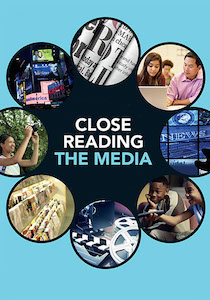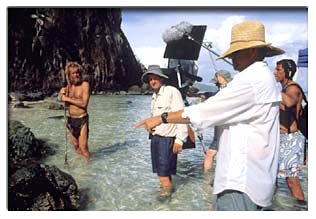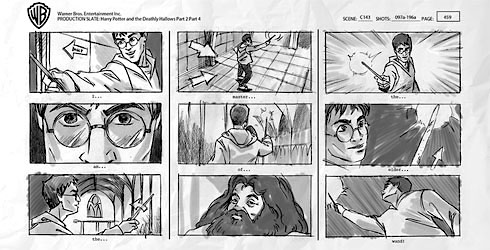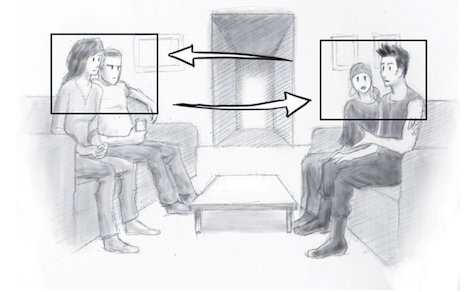Media Literacy: Explore the Art of Making Movies
A MiddleWeb Blog
 I dedicate my first post at this new MiddleWeb blog to media educator Elizabeth Thoman, who passed away in December 2016. She founded the Center for Media Literacy in 1989. I was honored to serve with her on the board of the alliance that became the National Association of Media Literacy Education (NAMLE). My approach to teaching media literacy was shaped by my many hours of watching Elizabeth do her groundbreaking work.
I dedicate my first post at this new MiddleWeb blog to media educator Elizabeth Thoman, who passed away in December 2016. She founded the Center for Media Literacy in 1989. I was honored to serve with her on the board of the alliance that became the National Association of Media Literacy Education (NAMLE). My approach to teaching media literacy was shaped by my many hours of watching Elizabeth do her groundbreaking work.
Watching a movie on the big screen or the small one is a nice experience. But have you ever thought about the fact that movies are considered works of art?
Movies….art? Really? There has been much debate about this since the invention of cinema. But filmmakers are serious about their craft and they want their audiences to appreciate everything that goes into making what are often multi-million dollar productions.
Alfred Hitchcock, Walt Disney, Ava DuVernay, Steven Spielberg, Martin Scorsese are just a few names of directors who bring strong art backgrounds to their films. And there are many other directors, not so famous, who approach their work with an artistic mind and eye.
As a media literacy educator, I am always using movies in my workshops to help teachers and students understand the language of film and how motion pictures work to engage our senses. And the reason I emphasize this media form is because most of us have seen hundreds, if not thousands, of movies on the screen but have limited experience examining the filmmaking process: how the film got onto the screen.
Is this really a subject for classroom study?
Common Core ELA middle grade standards specifically mention the importance of teaching film techniques as well as understanding the decisions made by filmmakers.
Movies are designed by people who have experience in art. (Many also have experience in science, math, engineering and technology. More about that later.) Movies are also texts worthy of close reading (as I have written about here previously) and they can be approached as illustrated stories.
 Movies can also be deconstructed to reveal topics of interest that span the entire K-12 curriculum, including English language arts and history, science and math, art and music, business and economics, and the technical and career areas – from computer technology to fashion design and the trade crafts.
Movies can also be deconstructed to reveal topics of interest that span the entire K-12 curriculum, including English language arts and history, science and math, art and music, business and economics, and the technical and career areas – from computer technology to fashion design and the trade crafts.
Let me share some examples.
Movie Marketing
Months before a movie is released, many of us will have been exposed – online, in print, or sitting in a theatre – to the movie’s marketing posters and perhaps even the film’s promotional trailer. Film studios have large marketing departments, and generating buzz is one of their primary objectives.
Both the poster and the trailer are art productions that precede the release of the film, and both can be considered persuasive texts – to pique our interest and eventually sell tickets, online viewings and DVDs.
So what goes into designing a movie poster? Here’s a brief video I have used, a tutorial, which deconstructs in specific detail the poster from Star Wars Episode One: The Phantom Menace. After your students have watched this, perhaps you might have them choose a favorite film and design their own poster. How did they decide what images and words would be most attractive, appealing, interesting and persuasive?
Movie Production
Think for a moment about the camera that captures the action on a film set. In many ways that professional camera is very similar to the one we might use to shoot photos and video in our personal lives.
Motion picture cameras depend on light to get a proper exposure, and before they yell ACTION, many cinematographers and directors consider horizon line, depth-of-field, focus, rule-of-thirds and other visual concepts familiar to those of us who’ve taken a photography class. All of these techniques have their basis in the world of painting.
In the book Flicks: Studying Film as Text, the authors reference other art concepts such as line, composition, shape, texture, light, color, rhythm, scale, proportion, monocular perspective and the illusion of depth/space/unity (here’s a sample). For introductory vocabulary, good additions to a classroom library might include How to Make a Movie in 10 Easy Lessons or Digital Filmmaking for Kids, both aimed at the middle grades age group.
Art direction combines craft and creativity
 One of the people intimately involved in the making of a movie is the Production (or Art) Director. It’s their job to create the visual look of the film, whether that’s creating Peter Pan’s Neverland inside a motion picture studio, or shooting Tom Hanks in Castaway on an island in the middle of the South Pacific.
One of the people intimately involved in the making of a movie is the Production (or Art) Director. It’s their job to create the visual look of the film, whether that’s creating Peter Pan’s Neverland inside a motion picture studio, or shooting Tom Hanks in Castaway on an island in the middle of the South Pacific.
The people who report to the production director include architects, construction workers, storyboard artists and more. (Suggested resource: How to Become A Film Art Director)
Storyboarding puts words into action
Every movie script must be translated into a visual product. And almost every filmmaker utilizes storyboards to visualize the words on the pages of the screenplay (script). It is these visual representations that are used by the entire film crew as the movie-making process gets underway.
Storyboards are created by artists. Some may be simple stick figures – others can be polished, dramatic representations of the story’s scenes and momentum. The goal of the storyboard is to give the filmmakers an idea of how the action might look.
 Here’s a teaching idea: If your students don’t have any prior knowledge or experience with film storyboards, you might wish to locate one or more online and share it with them.
Here’s a teaching idea: If your students don’t have any prior knowledge or experience with film storyboards, you might wish to locate one or more online and share it with them.
It’s easy to find storyboards from films by Hitchcock, Spielberg, Tim Burton or any number of other filmmakers. Or simply search Google Images for a phrase like movie storyboard examples.
In my workshops, I engage participants by having them first read a passage from a novel or other book and then, working in groups, draw (visualize) how that passage might look as a series of drawings (storyboards).
I utilize a six-frame storyboard (here’s one you can use) with each frame representing a different camera shot. The six frames represent a film scene. Upon completing their storyboards, each group shares their boards with the class. (Resource: How to Make A Movie Storyboard)
 In a panning shot, the camera moves first to one set of characters, then to the other. Arrows show direction of movement.
In a panning shot, the camera moves first to one set of characters, then to the other. Arrows show direction of movement.
Animation: Movement brings art to life
Nowhere is art more relevant than in animation. Animation is comprised of a series of still images which when photographed create the illusion of movement.
When animation first started, it involved artists drawing or painting on transparent acetate sheets (called cels). Today, animation can be accomplished using computer technology. Bridging the two eras is stop-motion animation like Kubo and the Two Strings (2016) which utilizes some of the same techniques used many years ago in films like The 7th Voyage of Sinbad (1958).
Animation artists study movement, expressions, body language and so much more. Animators for Disney’s The Lion King studied real lions to help them capture the look of the animal. Animators for Dreamworks’ Over the Hedge, said they visited the habitats of the small animals represented in that film so that they would understand their characters’ points of view.
Sophisticated computer programs now aid animators in creating realistic looking animal fur, clothing textures and more. Here’s another YouTube video where a stop motion animator describes his job (also on the set of Kubo and the Two Strings).
See my animation teaching resources here.
As your students explore behind the scenes of movie-making, it quickly will be apparent that movie makers include skilled crafts people working in a variety of roles – many of whom consider themselves to be artists. Many of these artists are members of the Academy of Motion Picture Arts & Sciences, the organization which honors filmmakers with the annual Oscar Awards.
In the coming months, I will examine how filmmaking also utilizes math, science, engineering and technology. Science and math educators would be smart to consider how to engage 21st century students with movies and their relationship to STEM and STEAM.


































Congratulations. A great achievement.